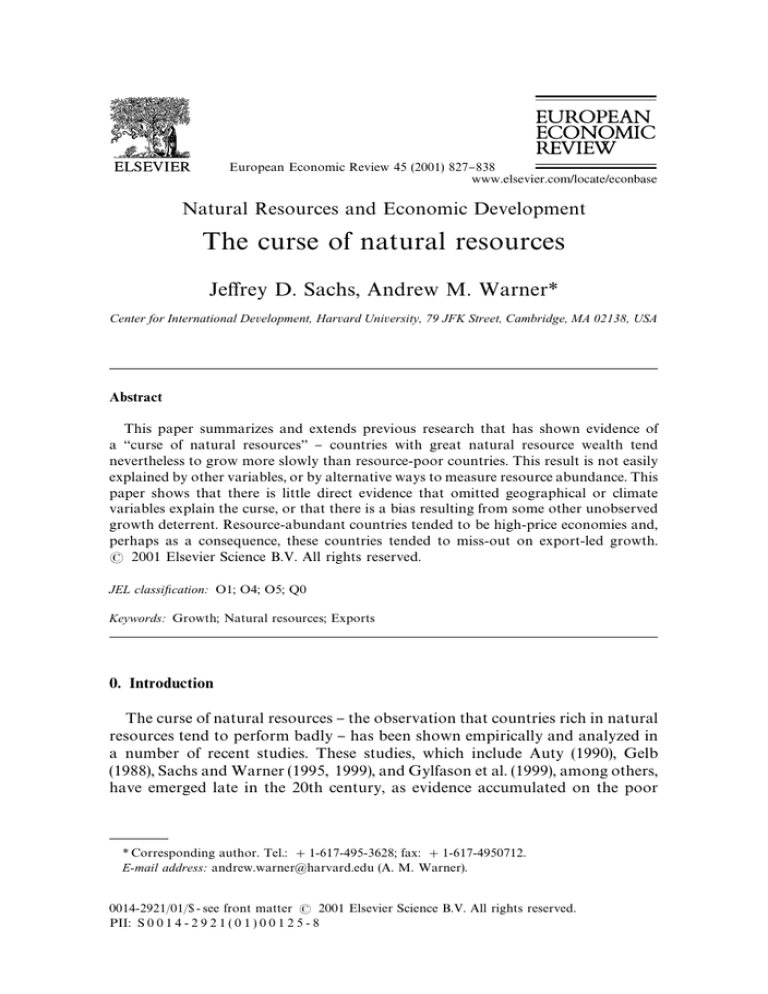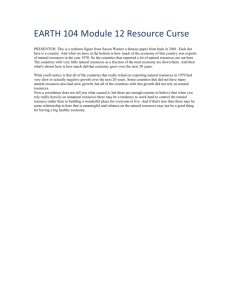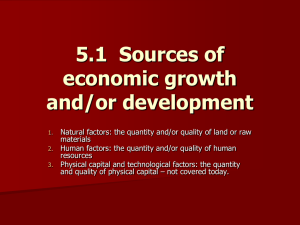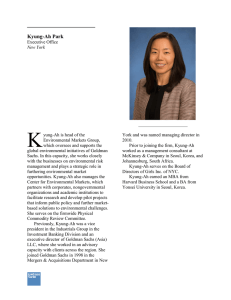
European Economic Review 45 (2001) 827}838
Natural Resources and Economic Development
The curse of natural resources
Je!rey D. Sachs, Andrew M. Warner*
Center for International Development, Harvard University, 79 JFK Street, Cambridge, MA 02138, USA
Abstract
This paper summarizes and extends previous research that has shown evidence of
a `curse of natural resourcesa } countries with great natural resource wealth tend
nevertheless to grow more slowly than resource-poor countries. This result is not easily
explained by other variables, or by alternative ways to measure resource abundance. This
paper shows that there is little direct evidence that omitted geographical or climate
variables explain the curse, or that there is a bias resulting from some other unobserved
growth deterrent. Resource-abundant countries tended to be high-price economies and,
perhaps as a consequence, these countries tended to miss-out on export-led growth.
2001 Elsevier Science B.V. All rights reserved.
JEL classixcation: O1; O4; O5; Q0
Keywords: Growth; Natural resources; Exports
0. Introduction
The curse of natural resources } the observation that countries rich in natural
resources tend to perform badly } has been shown empirically and analyzed in
a number of recent studies. These studies, which include Auty (1990), Gelb
(1988), Sachs and Warner (1995, 1999), and Gylfason et al. (1999), among others,
have emerged late in the 20th century, as evidence accumulated on the poor
* Corresponding author. Tel.: #1-617-495-3628; fax: #1-617-4950712.
E-mail address: andrew.warner@harvard.edu (A. M. Warner).
0014-2921/01/$ - see front matter 2001 Elsevier Science B.V. All rights reserved.
PII: S 0 0 1 4 - 2 9 2 1 ( 0 1 ) 0 0 1 2 5 - 8
828
J.D. Sachs, A.M. Warner / European Economic Review 45 (2001) 827}838
growth experience of resource-rich countries in the post-world-war II period.
On an intellectual level, this issue "rst emerged as an important international
issue during the inter-war period in Latin America, after many Latin American
economies su!ered from the global slump in commodity prices. However during
this time and in the immediate post-war period, the skepticism about natural
resource-led development was rooted in forecasts of declining global demand
and prices. What the studies based on the post-war experience have argued is
that the curse of natural resources is a demonstrable empirical fact, even after
controlling for trends in commodity prices. Since so many poorer countries still
have abundant natural resources, it is important to better understand the roots
of failure in natural resource-led development.
There have always been two important questions raised by the curse of
natural resources. Is it true? If so, why? Section 1 discusses the evidence on the
"rst question, Section 2 the second.
1. Does the curse really exist?
Empirical support for the curse of natural resources is not bulletproof, but it is
quite strong. First, casual observation suggests that there is virtually no overlap
in the set of countries that have large natural resource endowments } and the set
of countries that have high levels of GDP. Many resource-rich countries have
been resource rich for a long time. If natural resources really do help development, why do not we see a positive correlation today between natural wealth
and other kinds of economic wealth? Second, casual observation also con"rms
that extremely resource-abundant countries such as the Oil States in the Gulf, or
Nigeria, or Mexico and Venezuela, have not experienced sustained rapid economic growth. In addition, empirical growth studies tend to con"rm this casual
evidence. The "nding in repeated regressions using growth data from the
post-war period is that high resource intensity tends to correlate with slow
growth. This "nding is not easily explained by other variables, since this
empirical result survives the introduction of a long list of control variables. It is
also not easily explained as an accident from the special experience of the
Persian Gulf states, since most of these states drop out of regression samples for
lack of data on other control variables. In addition the "nding survives statistical procedures for eliminating unusual observations. For some examples of the
evidence, Sachs and Warner (1997) show regression evidence of the curse of
natural resources with as many as nine additional regressors, and Sachs and
Warner (1995) show regression evidence for the curse after controlling for
popular variables favored by four other empirical growth studies. In more recent
work, Sala-i-Martin (1997) and Doppelhofer et al. (2000) classify natural
resources as one of the ten most robust variables in empirical studies on
economic growth.
J.D. Sachs, A.M. Warner / European Economic Review 45 (2001) 827}838
829
Fig. 1. Growth and natural resource abundance 1970}1989.
Fig. 1 shows why regression studies such as Doppelhofer et al. (2000) tend to
"nd robust results. The "gure shows that none of the countries with extremely
abundant natural resources in 1970 grew rapidly for the next 20 years. This fact
holds up using a variety of measures of resource abundance. Moreover, most of
the countries that did grow rapidly during this period started as resource poor,
not resource rich. The exceptions to this general tendency were Malaysia,
Mauritius and Iceland. However, these were the only exceptions and, as one can
see from Fig. 1, they were not strong exceptions.
Although the empirical evidence mentioned above is strong by conventional
standards, we will now discuss a possible way that these results are misleading.
It is possible that the negative association is a by-product of a subtle bias. To see
this, suppose that there was an alternative variable, constant through time, that
a!ected growth. We will call it a country's geography for the purposes of
argument. Suppose also that countries were randomly endowed with natural
resources in a way that was not correlated with their geography. If we let time
pass in such a world, eventually the countries with favorable geographic conditions would have high income, since they would have been growing for a while.
Because of their high income, they would appear to have low shares of natural
resources in the economy } not because they were inherently poor in natural
resources, but because the rest of the economy would have been growing. On the
other hand, the poor-geography countries would still appear to be high-natural
resource economies, since the rest of the economy would not have been growing.
Now suppose we were to measure growth and natural resource as a share of
830
J.D. Sachs, A.M. Warner / European Economic Review 45 (2001) 827}838
GDP after this process had been unfolding for a while. We would tend to "nd
a negative association between growth and natural resources as a share of the
economy. But in our special example, this negative association would be driven
by geography which we do not observe, and not by any inherent penalty from
high natural resources.
There are at least two ways to test for this possibility. If it is hard to observe
the omitted variable a!ecting growth, one solution is simply to control for
previous growth rates in the regressions. Under the story above, previous
growth would be correlated with the left-out geography variables and thus serve
as a proxy for them. The relevant question then is whether the natural resource
variable stays in the regression even after controlling for previous growth. If
instead it is not hard to observe the omitted geography variables, the second
solution is simply to control for them in the regression.
Sachs and Warner (1997) looked at the "rst of these tests and found no
evidence that controlling for the previous decade's growth rate altered the
negative natural resource e!ect. The regression that contained this result is
reproduced in Table 1. Previous growth in this case is growth in the 1960s which
is listed as the last regressor.
Table 2 shows additional evidence on the second of the tests: controlling for
geography variables directly. The dependent variable is real growth per person
between 1970 and 1990. The regressors include the log of GDP in 1970, and then
a list of variables we have used in previous studies. These are: a variable
measuring the outward orientation of economic policy from Sachs and Warner
(1995); an interaction variable between this openness variable and initial income
(to allow for faster convergence of open economies); and natural resource
intensity measured by natural resource exports as a share of GDP (measured in
1970, before the growth period). The list of geography variables includes the
percent of land area within 100 kilometers of the sea, kilometers to the closest
major port, the fraction of land area in the geographic tropics and a falciparam
malaria index from 1966. These four geography and climate variables are taken
from Gallup et al. (1999).
The impact of geographical conditions on growth is studied in much more
detail elsewhere (see Gallup et al., 1999). The main point for our purpose is
simply to establish that the geography variables generally do not eliminate the
evidence for the curse of natural resources. There is no clear evidence from the
A third possible solution is to calculate natural resources per-capita so that GDP is not in the
denominator. However, this is not a good solution because we want to measure the importance of
natural resources in the economy, not just per-capita. For example, Canada has higher natural
resources per-capita than Zambia, yet in Zambia natural resource production is more than 50
percent of the economy while in Canada it is less than ten percent. Natural resources have much
more potential to crowd out other economic activities in Zambia than in Canada. To test
crowding-out theories, the better measure is percent of GDP.
J.D. Sachs, A.M. Warner / European Economic Review 45 (2001) 827}838
831
Table 1
Regression of economic growth on natural resource abundance, 1970}1990, controlling for growth
in the 1960s
Log GDP 1970
Natural resource abundance
OPEN
Log investment
Rule of law
Terms of trade change
Growth 1960}1969
R
N
!1.8
(8.87)
!9.9
(6.50)
1.3
(3.2)
0.8
(2.4)
0.4
(3.8)
0.1
(2.1)
0.02
(0.2)
76%
69
Source: Sachs and Warner (1997).
regressions in Tables 1 and 2 that there was an omitted variable in our previous
growth regressions that can account for the curse of natural resources.
This concludes the section on whether the `curse of natural resourcesa
is a statistical mirage from natural resources being the only surviving sector
in slow-growth countries. To summarize, the evidence is not supportive for
two reasons. Controlling for previous growth rates does not eliminate
the natural resource variable from the regression. And direct controls
for geography and climate variables do not eliminate the natural resource
variable.
We also wish to mention two other empirical points that are sometimes raised
about the resource curse "nding. Sometimes it is argued that the natural
resource e!ect should be linked to the magnitude of economic rents from the
natural resource, and thus we should distinguish minerals (which generally have
high rents) from agriculture (which generally has low rents). In the same vein,
perhaps processed agriculture should be distinguished from primary agriculture.
The main response to these objections is practical. The variation in mineral
exports across countries is responsible for a large fraction of the overall variation in the natural resource variable, so that the inclusion or exclusion of
agriculture does not much alter the basic empirical results. The countries, which
do have signi"cant natural resource exports other than minerals, include Iceland
("sheries), Fiji, Cote d'Ivoire, and Mauritania. For most country's, however,
changes in the de"nition of natural resources is not as quantitatively important
as one might think.
832
J.D. Sachs, A.M. Warner / European Economic Review 45 (2001) 827}838
Table 2
Growth regressions with the natural resource variable and the geography and climate variables.
Dependent variable: growth per-capita 1970}1989
Log GDP per pop '70
GDP70;OPEN 1
Share of years open (OPEN)
Natural resource abundance
(N.R. exports/GDP in 1970)
% Land w/in 100 km coast
(1)
(2)
(3)
(4)
(5)
!0.31
(1.00)
!1.52
(3.34)
16.21
(4.19)
!0.05
(4.91)
0.63
(1.27)
!0.20
(0.67)
!1.68
(3.72)
17.63
(4.64)
!0.05
(4.29)
!0.37
(1.19)
!1.82
(4.08)
18.77
(4.98)
!0.04
(3.44)
!0.69
(2.12)
!1.13
(2.58)
12.75
(3.44)
!0.04
(3.72)
!0.86
(2.51)
!1.11
(2.33)
12.45
(3.11)
!0.03
(2.57)
0.60
(1.20)
0.00
(0.14)
!0.64
(1.23)
!1.22
(2.16)
8.48
(3.06)
93
0.59
Km to closest major port
0.00
(0.28)
% Land in geographical tropics
!0.87
(1.77)
Falciparam malaria index, 1966
Constant
Observations
R
3.40
(1.42)
97
0.57
2.79
(1.17)
97
0.57
4.52
(1.79)
97
0.58
!1.41
(2.86)
7.17
(2.66)
94
0.58
Joint signi"cance test for Geography Variables in regression (5): F(4,85)"3.04 P-value"0.022.
Absolute value of t-statistics in parentheses.
Signi"cant at 5% level.
GDP70;OPEN is an interaction variable where GDP70 is the log of GDP per-capita in 1970
and OPEN is the shorter name for `share of years opena from Sachs and Warner (1995).
Signi"cant at 1% level.
A "nal empirical issue concerns the widespread popular impression that many
currently rich countries once developed with the aid of their natural resources.
Many are surprised by the resource curse "nding because it runs against the
textbook story in history books or common discussion of growth advantages.
One example is an in#uential work by Habakkuk (1962) who argued, among
many other points, that greater natural resource endowments in the United
States helped explain why it surpassed England in the 19th century. As a further
example, note that the bene"cial e!ects of natural resources are still being
stressed for some developing countries. As recently as August 2000, President
Clinton's speech in Nigeria stressed that `With...vast human and natural resources, a revitalized Nigeria can be the economic and political anchor of West
Africa2a (Quoted on the web, August 27, 2000).
We mention two points on this. First, although the data are scarce, when one
measures natural resource intensity using historical data, the ratios as a percent
J.D. Sachs, A.M. Warner / European Economic Review 45 (2001) 827}838
833
of GDP are much smaller than the ratios that many countries have achieved in
the mid-to-late 20th century. Sweden, Australia and the United States in earlier
times never approached the level of natural resource intensity we see today in
the Gulf-States. Second, Habakkuk's argument could be credible for an earlier
period during which cheep power from the proximity of coal was more technologically essential. With the emergence of the petroleum-based economy and
revolutions in global transportation, cheep energy can be transported today in
a way that was impossible earlier.
2. What explains the curse?
Just as we lack a universally accepted theory of economic growth in general,
we lack a universally accepted theory of the curse of natural resources. Most
current explanations for the curse have a crowding-out logic. Natural Resources
crowd-out activity x. Activity x drives growth. Therefore Natural Resources
harm growth. Since there is a diversity of views regarding the second of these
statements (what exactly drives growth), we have a similar diversity of views on
the natural resource question. In other words, a complete answer to what is
behind the curse of natural resources therefore awaits a better answer to the
question about what ultimately drives growth. Nevertheless, we can review some
of the leading explanations.
Sachs and Warner (1995, 1999), and Sachs (1996) identify x with tradedmanufacturing activities. The mechanism is familiar. Positive wealth shocks
from the natural resource sector (along with consumer preferences that translate
this into higher demand for non-traded goods) creates excess demand for
non-traded products and drives up non-traded prices, including particularly
non-traded input costs and wages. This in turn squeezes pro"ts in traded
activities such as manufacturing that use those non-traded products as inputs
yet sell their products on international markets at relatively "xed international
prices. The decline in manufacturing then has rami"cations that grind the
growth process to a halt.
To test whether this explanation is credible, the "rst step is to show that
natural resource abundance is indeed correlated with higher non-traded prices
across countries. It is di$cult to observe non-traded prices directly because
national statistical o$ces do not divide products neatly into traded and nontraded categories. However, if the non-traded prices in resource-abundant
countries are higher and the traded prices across countries are roughly equal
then it follows that the general price level (which is a weighted average of the
two) will be higher in resource-abundant countries. Since the general price level
is observable we can use this data to test the proposition.
Many observers have noted that national price levels tend to be positively
associated with levels of income across countries. There are theoretical reasons
834
J.D. Sachs, A.M. Warner / European Economic Review 45 (2001) 827}838
for this which go back to Ricardo, Viner, Ballasa and Samuelson. For our
purposes, and to save space, we can take this as an established empirical
regularity that all countries obey, regardless of their natural resource intensity.
Our test of overvaluation is to see whether natural resource intensive economies
had higher price levels after controlling for this universal law. In other words, we
control for the systematic relationship between price levels and (non-natural
resource) GDP and see whether natural resource intensive economies had
higher relative prices on top of this.
We measure the relative price level across countries by taking the ratio of two
measures of GDP. The numerator is GDP in US dollars measured by using
local current prices and the nominal US dollar exchange rate (in symbols
>HP/E). The denominator is the same GDP evaluated at international prices
(>HP$). These international prices are averages across many countries of prices
for certain goods, and therefore do not vary by country. The ratio of these two is
typically a number (a fraction) that gives the country's price level relative to
a global average of prices. The number is equivalent to what is also referred to as
ratio of the country's purchasing power parity exchange rate to its nominal
exchange rate (explained in more detail in Summers and Heston (1991)).
The regression below shows the essential results. There is a positive relationship between the log of the relative price level during any year of the 1970s and
natural resource intensity in 1970, after controlling for the income e!ect mentioned above. The particular regression below is for the year 1979, but the
general result also holds for all years during the period 1970 to 1980.
Log(PLEVEL79)"3.6#0.27 log(RGDP79)#0.69 SXPR70
(13.6)
(3.5)
N"99, R"66%
This equation shows that natural resource intensive economies did indeed
tend to have higher price levels. This e!ect obtains after controlling for the
average cross-country relationship between price levels and per-capita income
(income in all economies is measured after excluding natural resources). This
provides some evidence that one of the consequences of resource abundance in
the 1970s was that other businesses in resource-abundant country's had to try to
compete with higher than normal price levels. To the extent that they used
domestic inputs and sold products on international markets their competitiveness su!ered.
We now examine whether this lower competitiveness impeded export growth.
To do so, we derive a proxy for the contribution of export growth of manufactures to GDP growth over the full 20-year period 1970}1990. Mathematically,
See Kravis and Lipsey (1988) for further evidence and explanations on this subject.
J.D. Sachs, A.M. Warner / European Economic Review 45 (2001) 827}838
835
the contribution of export growth of manufactures to GDP growth is given by
growth in value added from manufacturing exports between 1970 and 1990
times the share of manufacturing exports in GDP in 1970, or in symbols
sx;gx. Countries will have a small contribution from exports of manufactures
if either exports grow slowly or if these exports represent a small share in the
economy.
Fig. 2 shows the relation across countries between the log of the export
contribution to growth during the period 1970}1990 and the log of natural
resource abundance in 1970. There is a strong inverse relationship. Resource
abundant countries tended to have small contributions from export growth in
manufactures. The tendency shown above for natural resource intensive economies to have high price levels may be part of the reason for this, but there are
probably other causes too, such as lack of active promotion of exports. Whatever the cause, it is clear that we have not seen strong export-led growth in
resource abundant economies.
Therefore, one explanation of the resource curse is that resource abundance
tended to render the export sectors uncompetitive and that as a consequence
resource-abundant countries never successfully pursued export-led growth. We
continue now with a summary of other explanations.
In Gylfason et al. (1999), and Gylfason (2000) in this issue the culprit &x' is
education. Furthermore, the basic logic could be extended to other variables
relevant to growth. Natural resource abundance could crowd-out entrepreneurial activity or innovation, if wages in the natural resource sector rise high
enough to encourage potential innovators and entrepreneurs to work in the
resource sector. In the same vein, since natural resource rents are concentrated
and (in some cases) easily appropriable, government o$cials in such countries
are tempted into rent-seeking and possible corruption rather than pro-growth
activities. Natural resource countries would thus experience lower innovation,
lower entrepreneurial activity, poorer governments and lower growth. Also
important are Auty (2000) points about how the political process gets captured
in resource-abundant economies. This is another form of crowding in which
a predatory state eclipses the developmental state.
It seems fair to say that some variant of these crowding-out stories are the
most likely explanations for the curse of natural resources, although further
re"nement is needed. Other possible explanations do not pass even a cursory
look at the data. For example, Sachs and Warner (1997) found little evidence
that resource abundance was associated with lower savings and investment.
Our measure is a proxy because we are forced to use gross exports rather than value added.
However, we would expect that growth in these two should be highly positively correlated.
Sachs et al. (1997) show a strong simple correlation between fast growth in manufacturing
exports and overall economic growth during this period.
836
J.D. Sachs, A.M. Warner / European Economic Review 45 (2001) 827}838
Fig. 2. Natural resource intensive economies have had smaller contributions from exports of
manufactures to overall GDP growth.
Second, although there is evidence that resource abundance is associated with
more authoritarianism, there is unfortunately only weak evidence for an association between non-authoritarian political systems and growth. The same goes
for income inequality. It is also sometimes said that natural resource countries
waste the natural resources on unproductive projects. Yet this by itself does not
explain slow growth, it just explains a permanently lower level of GDP than the
country would have enjoyed with optimal use of its natural resources.
We also wish to highlight the evidence for crowding out of entrepreneurial
activity, which is less discussed in the natural resource context. If one looks at
detailed wage data in resource abundant countries, one of the interesting
"ndings is that one often sees a wage premium in natural resource sector. For
example in Trinidad and Tobago, an index of average weekly earnings of
production workers, which took the value 100 in 1977, was, by 1996, 1048 in the
Oil Sector and only 398 in assembly-type industries (Central Statistical O$ce,
Trinidad and Tobago, `Annual Statistical Digesta, 1996, p. 101).
If these were workers of similar skills (and the data give us no reason to think
otherwise since they are listed under the same classi"cation of `production
workersa), this runs counter to simple Dutch Disease notions whereby resource
abundance raises wages of similarly skilled workers in all sectors. These di!ering
J.D. Sachs, A.M. Warner / European Economic Review 45 (2001) 827}838
837
wages may indicate some selection where the petroleum workers are
more productive in unobserved ways, or there may be some implicit
compensation for more dangerous working conditions. A third possibility is that
a labor aristocracy has developed which preserves higher wages in the petroleum sector.
If this is going on, then we cannot say that assembly manufacturing is
being crowded out by the petroleum sector, through higher wages, because it
does not necessarily have higher wages. However, if this kind of wage premium
extends to jobs that entrepreneurs might take, the existence of the wage premium creates a big incentive for entrepreneurs and rent seekers to invest in
trying to gain entry into the petroleum sector. To the extent that entrepreneurial
talent is in limited supply, this will crowd out growth-promoting entrepreneurship of all kinds.
3. Conclusion
The level of natural resource intensity experienced by some countries in the
mid-to-late 20th century, particularly mineral-intensive countries, seems to have
been historically unprecedented, at least according to the limited data available
for earlier periods. Almost without exception, the resource-abundant countries
have stagnated in economic growth since the early 1970s, inspiring the term,
`curse of natural resourcesa. Empirical studies have shown that this curse is
a reasonably solid fact. It is not easily explained by other variables, or by
alternative ways to measure resource abundance. This paper shows that there
is little direct evidence that omitted geographical or climate variables
explain the curse, or that there is a bias resulting from some other unobserved
growth deterrent. We also show evidence that resource-abundant
countries tended to be high-price economies and that, partly as a consequence,
these countries tended to miss-out on export-led growth. Except for the direct
contribution of the natural resource sector itself, which, for example, explains
much of the rapid growth of Botswana, natural resource abundant countries
systematically failed to achieve strong export led growth or other kinds of
growth.
References
Auty, R.M., 1990. Resource-Based Industrialization: Sowing the Oil in Eight Developing Countries.
Oxford University Press, New York.
Auty, R.M., 2000. The political economy of resource-driven growth. Paper presented at the 15th
Annual Congress of the European Economic Association, Bolzano August}September.
Gallup, J.L., Sachs, J.D., Mellinger, A.D., 1999. Geography and economic development, International Regional Science Review 22 (2), 179}232.
838
J.D. Sachs, A.M. Warner / European Economic Review 45 (2001) 827}838
Gylfason, T., Herbertsson, T.T., Zoega, G., 1999. A mixed blessing: Natural resources and economic
growth. Macroeconomic Dynamics 3, 204}225.
Gylfason, T., 2000. Natural resources, education and economic development. Paper presented at the
15th Annual Congress of the European Economic Association, Bolzano, August}September.
Gelb, A.H., 1988. Windfall Gains: Blessing or Curse?. Oxford University Press, New York.
Habakkuk, H.J., 1962. American and British Technology in the Nineteenth Century. Cambridge
University Press, Cambridge, MA.
Kravis, I.B., Lipsey, R.E., 1988. National price levels and the prices of tradeables and nontradeables.
American Economic Review, Papers and Proceedings, May.
Sachs, J.D., 1996. Resource endowments and the real exchange rate: A comparison of Latin America
and East Asia. Presented at the Seventh Annual East Asian Seminar on Economics, Hong Kong,
June 19.
Sachs, J.D., Warner, A.M., 1995. revised 1997, 1999. Natural resource abundance and economic
growth. National Bureau of Economic Research Working paper No. 5398, Cambridge, MA.
Sachs, J.D., Warner, A.M., 1999. The big push, natural resource booms and growth. Journal of
Development Economics 59, 43}76.
Sachs, J.D., Warner, A.M., 1997. Sources of slow growth in African economies. Journal of African
Economies 6 (3), 335}376.
Sachs, J.D., Radelet, S., Lee, J.-W., 1997. Economic growth in Asia. Prepared as background for
Asian Development Bank's study: Emerging Asia: Changes and Challenges. HIID Discussion
paper no. 609, May 1997.
Sala-i-Martin, X., 1997. I just ran two million regressions. American Economic Review, Papers and
Proceedings, May.
Doppelhofer, G., Miller, R., Sala-i-Martin, X., 2000. Determiniants of long-term growth: A Bayesian
averaging of classical estimates (BACE) approach. NBER 7750 June.
Summers, R., Heston, A., 1991. The Penn World Table (Mark 5): An expanded set of international
comparisons, 1950}1988. Quarterly Journal of Economics CVI (May) 327}368.






